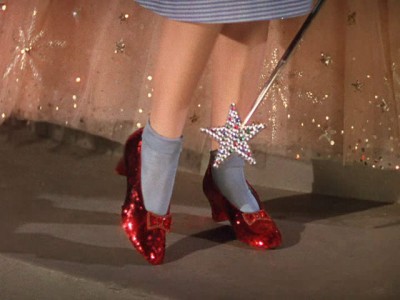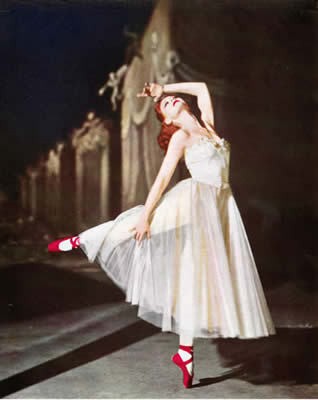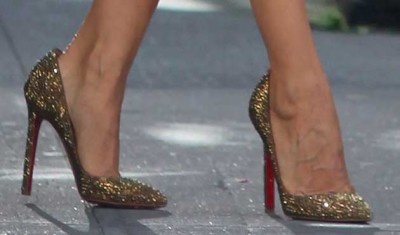A Little History Of Red Shoes
by Rachelle Bergstein

This past April, Christian Louboutin filed a lawsuit against couture competitor Yves Saint Laurent, claiming that the legendary fashion house had committed trademark infringement when it manufactured and sold shoes with a ruby-red sole. On Monday, the NY Post reported that YSL’s representatives had argued in court documents that the red sole cannot be considered proprietary to Louboutin: “Red outsoles are a commonly used ornamental design feature in footwear, dating as far back as the red shoes worn by King Louis XIV in the 1600s and the ruby red shoes that carried Dorothy home in The Wizard of Oz.”
Historically speaking, this is true! Red shoes — if not always red soles — have long been associated with issues of power and identity. During the reign of Louis XIV, only aristocratic men had the right to wear shoes with red heels — they were strictly reserved for the court. Thus the color neatly distinguished between the haves and have-nots. Red dye at the time was expensive, made by crushing the dried bodies of an imported Mexican insect called the cochineal, and only royals and their cohort could afford it. The shoes went out of style with the French Revolution — not a time when one flaunted one’s wealth and status.
Two centuries later, Danish author Hans Christian Andersen contributed significantly to red shoe mythology. In his story “The Red Shoes,” a young peasant girl named Karen is adopted by a woman of the gentry — but Karen fails to appreciate her good fortune, and instead aspires to transcend class boundaries even further. One day, she spots a princess. Red morocco shoes peep out from beneath the princess’s dress. Karen brazenly tricks her adopted mother into buying her a pair of her own then, instead of attending to family obligations, wears the shoes to go out dancing. She finds that once she starts dancing, she can’t stop, nor can she remove the demonic shoes from her feet.
She danced, and was obliged to go on dancing through the dark night. The shoes bore her away over thorns and stumps till she was all torn and bleeding; she danced away over the heath to a lonely little house. Here, she knew, lived the executioner; and she tapped with her finger at the window and said:
“Come out, come out! I cannot come in, for I must dance.”
And the executioner said: “I don’t suppose you know who I am. I strike off the heads of the wicked, and I notice that my axe is tingling to do so.”
“Don’t cut off my head!” said Karen, “for then I could not repent of my sin. But cut off my feet with the red shoes.”
And then she confessed all her sin, and the executioner struck off her feet with the red shoes; but the shoes danced away with the little feet across the field into the deep forest.
Andersen’s moralistic fairy tale may not serve as the most appealing advertisement for red shoes, but it certainly attests to their potency.

When The Wizard of Oz appeared in movie theaters in 1939, the connection between the color red and the magic of footwear was strengthened further. MGM’s costume designer, Adrian, who distinguished himself on the studio lot by designing glamorous gowns for silver screen starlets like Jean Harlow, experimented with a few different versions of Dorothy’s sequined shoes before he settled on the final design: a simple, round-toed medium-high pump with a matching bow. The ruby slippers, like Judy Garland’s pigtails and her blue gingham smock, were meant to underscore the character’s innocence which, given the lingering effects of the Great Depression and the threat of World War II, director George Cukor believed to be crucial to the film’s success. Interestingly, Dorothy’s shoes were originally silver — a holdover from L. Frank Baum’s original children’s story — and the switch to “ruby” came relatively late in the screenwriting process. It was assumed that red would look better in Technicolor. Without that one, momentous decision, Louboutin and YSL might be locked in a lawsuit over sparkling silver soles today.

In 1948, The Red Shoes, the magnificent film adaptation of Andersen’s story, debuted. Now set in the competitive world of classical ballet, this version downplayed the economic implications of the original fairy tale; instead, the story was infused with a healthy dose of gender politics, at a time when the war (and the related rise in female employment) had complicated the country’s understanding of the traditional roles for men and women. Vicky, the flame-haired protagonist played by Moira Shearer, is an aspiring dancer, hungry to win admiration for her talent as a prima ballerina. She achieves her dream with the help of a controlling director, who casts her as the lead in the ballet “The Red Shoes”: a shadow story that more closely resembles Andersen’s original. When Vicky falls in love, she’s forced to decide between her husband and her passion. Ultimately, she chooses dance — and fame. Then, slipping on her red toe shoes for her performance, she feels an overwhelming urge to dance off the theater’s balcony, where she plummets to her death.
Like Karen, Vicky is punished for attempting to bypass social boundaries, and for deeming her desires more important than the obligations of her wedding vows. The power of the red shoes lies in their ability to reveal some fundamental truth about the wearer — and deliver a penalty, or prize (as in The Wizard of Oz), accordingly.

But today’s lawsuit isn’t just about red shoes. Anyone can manufacture and sell those; every holiday season designers from Miuccia Prada to Steve Madden churn out festive red sequin pumps that are a wink at ruby slippers. In the case against Yves Saint Laurent, Louboutin isn’t laying claim to the color red. He’s defending his use of the red outsoles that are the brand’s signature. Ever since the days when Sex and the City was a hit show on HBO, shoes have attained a cult-like status in this country, and buying expensive, high-fashion footwear is now considered a rite of passage for any aspiring fashion maven. In the ’90s, the most coveted shoes were those designed by Manolo Blahnik, but then Christian Louboutin, France’s secret weapon, arrived on the scene. By 2008, when the much anticipated Sex and the City movie premiered, even the franchise that made Manolo famous had switched its allegiances. Carrie Bradshaw, who had once told a mugger, “Please, sir, You can take my Fendi baguette, you can take my ring and my watch, but don’t take my Manolos Blahniks,” now wore Louboutins.
What makes Louboutin soles so brilliant is that it only takes a smidge of pop-culture consciousness to identify them, unlike a Blahnik shoe, whose more subtle identifying marks (quality, shape, whimsical embellishments) require some fluency in footwear to discern. People who can’t tell the difference between a Giuseppe Zanotti and a Jeffrey Campbell see the flash of red and know they’re looking at a Louboutin.
In the last decade, Louboutin’s red soles have become a sort of visual shorthand that signals a woman’s high economic status and power. They also carry an undercurrent of the risqué, like the glimpse of a red lace bra strap under a conservative blouse. In this way, Louboutin’s shoes have become the stuff of a modern-day fairy tale. Just as in Andersen’s story, they symbolize independence and high status. The woman who wears them is given the opportunity to transcend economic and social boundaries — except this being branding, and not grim Danish storytelling, she ends up, not ashamed, but “empowered” by the shoes. Time and again, pop culture reinforces this narrative. In Jennifer Lopez’s single “Louboutins,” she invokes the red sole as the last thing her cheating lover will see now that she’s found the courage to leave him (not unlike Nancy Sinatra’s calling upon the strength of her boots to keep her walking). 2009’s silly thriller Obsessed showed Ali Larter’s character — a sexy temp with a pathological crush on her married boss — climbing his stairs at the climax of the movie with her red soles flashing behind her. And recently, the heroines of two USA dramas, “Covert Affairs” and “Fairly Legal” have been costumed in Louboutins to underscore their status as successful, self-possessed women.
It’s been pointed out that YSL has occasionally manufactured and sold shoes with red soles as far back as the 1970s. And it remains to be seen whether Louboutin can defend his brand’s trademark against his rival in court. What is clear, though, is that Louboutins are a historically significant new take on our long fascination with ruby slippers.
Rachelle Bergstein’s Women From the Ankle Down — a social history of women and shoes — will be published by HarperCollins in Spring 2012. She blogs passionately (if infrequently) at The High-Heeled and is in the breathless second-date stage with twitter.
